Surface pumps for drip irrigation. Features of the use of submersible pumps for watering the garden. When to take a submersible unit
Warm sunny days delight the summer resident. However, with the onset of the hot season, the work of the owners of the plots is noticeably increasing.
The most laborious of them is the daily watering of the garden. If you are in great shape, carrying two dozen buckets of water will not make it difficult for you. But to manually drink bushes and trees growing on 5 acres is simply unrealistic.
Pump sets have been used a lot lately. Pump kit: can be used for drip irrigation and sprinkler irrigation. With drip irrigation, you have no limit. Case Study: A 10-hectare drip irrigation system can be perfectly controlled by solar powered pumps.
Submersible Solar Water Pump Irrigation: High Pressure
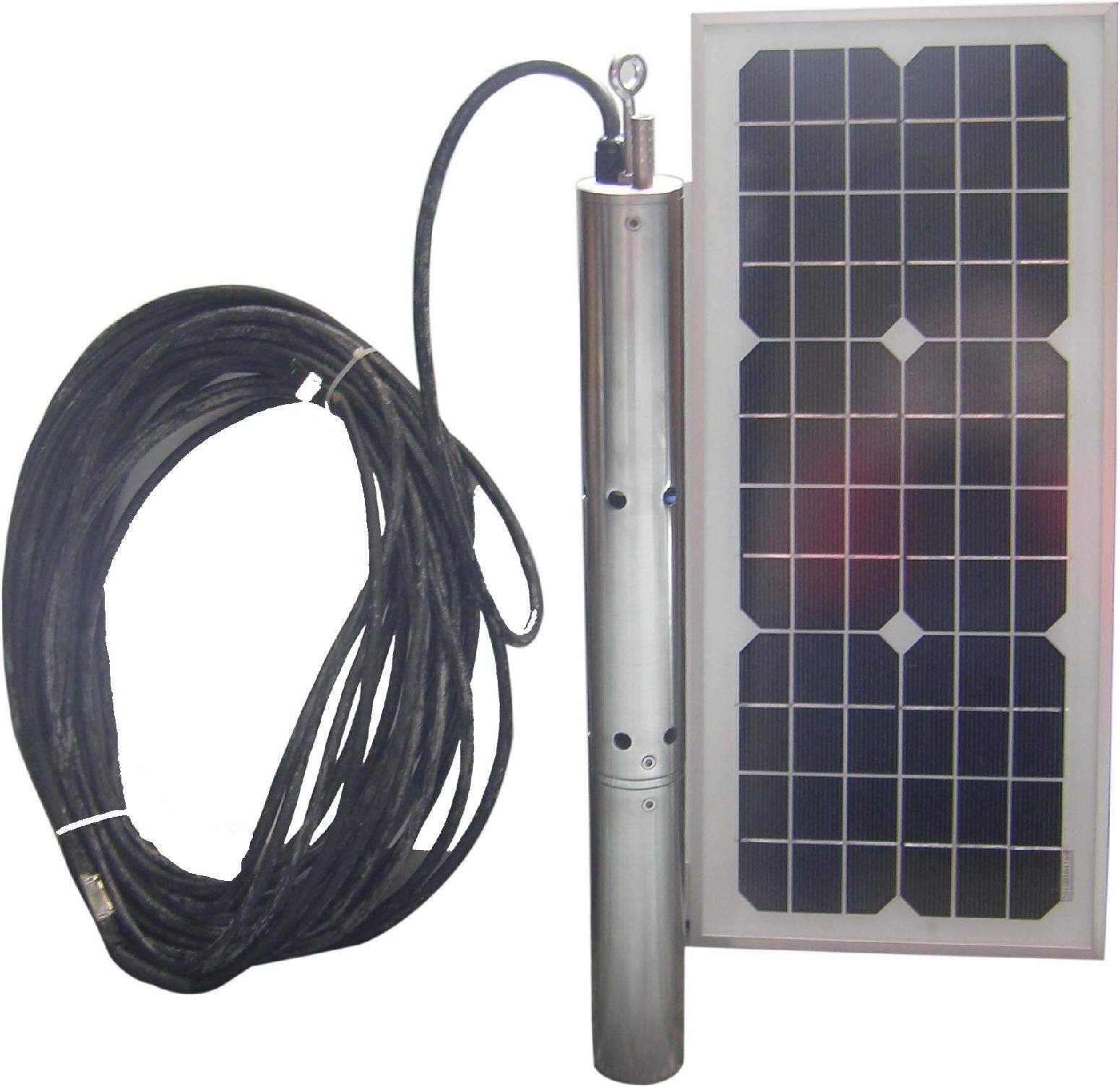
If you have any doubts, you can clear it. They can slow down prices, but it's worth it. Until now, water pressure groups and pumping groups used in agriculture have worked on diesel fuel or gasoline. Fuel consumption is exacerbated by the transportation and discomfort that it entails. When using solar water irrigation pumps, the energy that you create is small, so there is no shortage of bringing water to electricity. But, nevertheless, it allows you to get water where you need it.
This work can be done using an electric pump. It is necessary for irrigation of a large garden, as well as to maintain the grass in a proper form.
Given the importance of pumping equipment for the care of green spaces, the question of its choice cannot be called simple.
Here you have to consider a number of factors:
Solar Water Pump Irrigation
The surface pump is used for relatively small water requirements. It can be used for irrigation on a small scale, in a field that is not very large and landscaped, which does not require much water. Sometimes this type of water pump is also used in livestock farms, for irrigation of pastures or for producing water for animals. There is also another application in which this type of water pump is used a lot in low or basement floods.
Let's talk about pricing, how much can it cost?
Water pumps: wells, their wider use. Solar submersible pumps have other more specific uses: they are used to extract water from wells, ponds, or underground sediments. But what can we do with submersible pumps: clean water or dirty water? Using solar pumps is a good solution, especially in houses where there is a well, or a cistern, to use clean rainwater and not have sewage, so their dirty water flows into the septic tank.
- Type of source (well, open reservoir, well, capacity);
- Degree of water pollution;
- The need for heating;
- The amount of water needed for daily watering.
In addition, you need to take into account the moments affecting the technical parameters of the pump unit:
- The distance from the source of water intake to the extreme point of the irrigated garden;
- The difference in height from the installation site of the pump to the most distant point of the site;
- Frequency of watering;
- Irrigation area;
- Type of irrigation (drip, under the root, sprinkling).
Today in the market you can find various pumps for watering the garden and the garden. We will tell you how to choose a unit that is optimal for different water supply options in a review.
And of course, when it comes to raising water, you should have a clear equation: a submersible pressure pump. 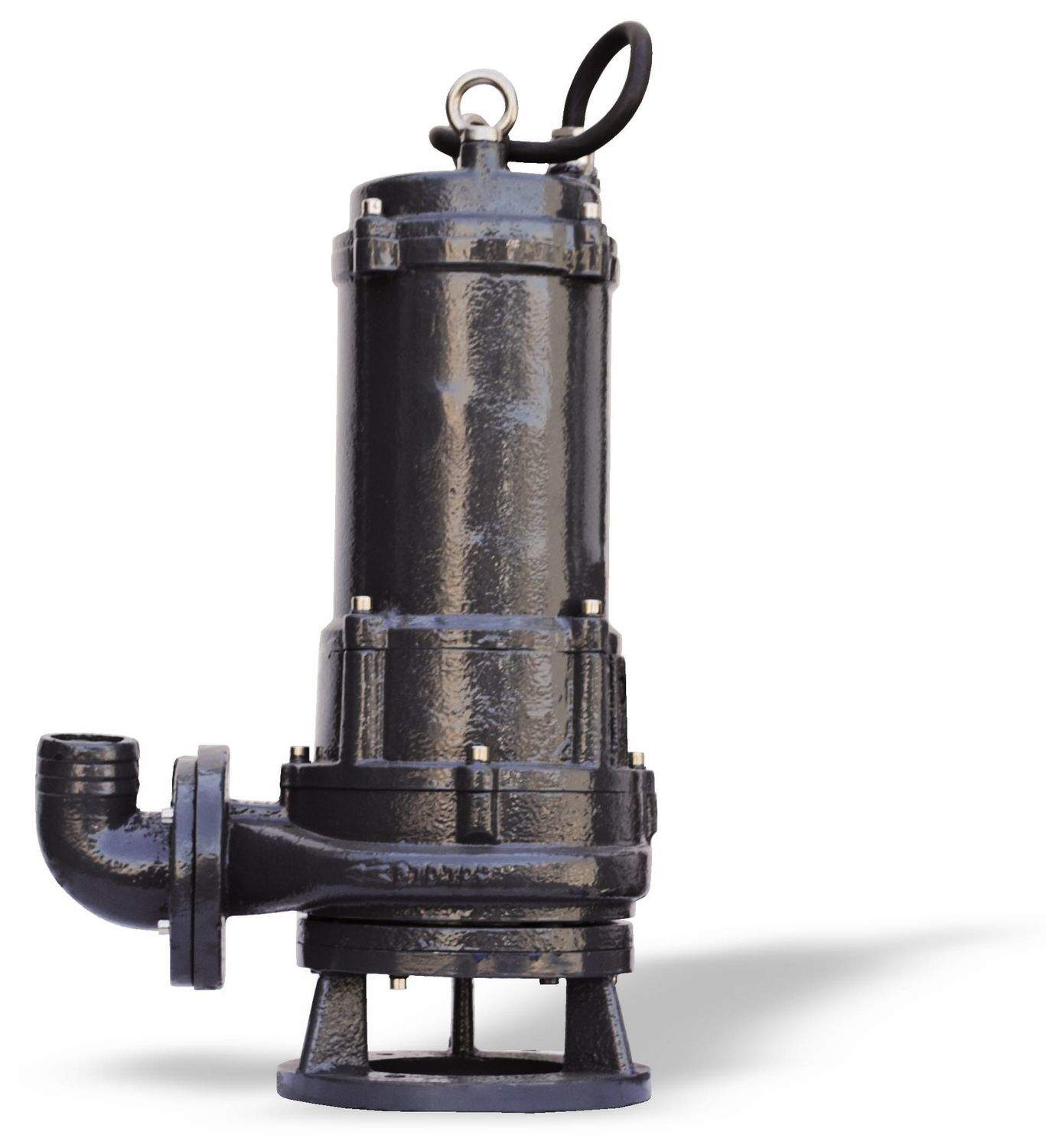
But they also have some lesser known applications. For example, these pumps also serve for transporting salt water. Submersible water pumps with this function are used as a bilge pump in small boats.
The most affordable pumps have an extraction capacity of 3 to 9 liters of water per minute. The performance and price of the pump are not as important as you think. For example, you can find a submersible pump with a volume of 3 liters per minute from 60 euros, but this does not mean that 9 liters will cost you three times. On the other hand, you can more agree with the set of pumps that carries the pump and accessories. The pumping kit consists of one or more solar panels, a controller to maximize the use of the installation, a water pump and a water tank.
Where is the water from?
The main factor influencing the choice of the pump is the source of water intake. For irrigation, warm and settled rainwater is best suited. Unfortunately, one 200-liter barrel where it is collected is not enough to irrigate even a small garden. Therefore, they most often use the option of taking water from wells and boreholes.
For benefits and quality you can always increase, although you do not need to go to the most expensive. Enough to have a basic performance and brand with acceptable reliability and the right accessories. 
There are several solar water pumps for wells with a special connection for solar panels and others that indirectly connect. The advantage of the latter is that you can use it even if you do not consume the energy generated by solar panels.
Garden plants do not like cold water from such sources, so many summer residents use a compromise option. They pump cold water from the well into the barrel, let it warm up during the day, and in the evening water the garden.
The happiest are those who have an artificial pond on the site, a river flows nearby or there is a lake. Water in such sources is warm and suitable for irrigation at any time of the day.
Do you want to find it for your installation? An interesting application is pumping water in places where it is difficult to find an electrical outlet, such as camping or a camper. Auxiliary pumps, panels and supports. Excursions, the most common, are to see such bombs in houses with land and a garden. They are used for sprinkler irrigation with very good results. A large capacity pump is not needed, but when it is used every day at the end, it is indicated on the invoice. A solar-powered pump means significant savings.
Surface pumps: “friends” with ponds and shallow wells
Another application is to improve pressure. Sometimes on the top floor of a town house it seems that pressure is not enough. With a 12-volt pump, you can solve the problem economically. You can find them from 50 euros, and you will no longer spend a dime on electricity.
We select a pump for irrigation
For irrigation of the garden, several types of pumps are used:
- Submersible.
- Superficial.
- Barrel.
- Drainage.
Submersible pumps
Presented in two structural options: centrifugal and vibrating. The first type is used in artesian wells. The vibrating watering pump for summer cottages is optimal for ordinary wells receiving water from shallow horizons (7-16 meters).
Have you heard about shurflo bombs? They are special water pumps to use solar energy at home, in addition to creating hot water. They can be connected to any electrical outlet or to a photovoltaic system. You only need a solar panel and accessories for pumps and supports.
If one day you need to carry out maintenance of your solar panels, you will not have pressure at the top of your house. Depending on the series you choose, you will have more or less power, but almost any of the options you choose will be sufficient. You can use it to transfer or reuse water, for example, in a garden or a fountain. Most models have an adjustable pressure sensor, which allows you to adjust the pump according to the required pressure. It provides a maximum flow rate of 6 liters per minute with a maximum power consumption of 102 watts. One of the most valuable features is its silent operation. . This will prevent the pump from starting every time you turn on the tap.
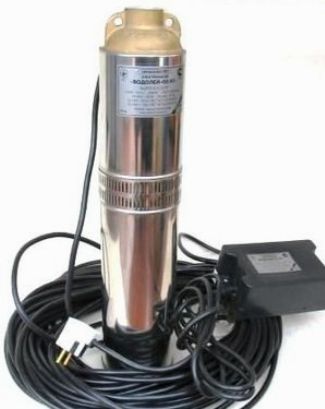
The main advantage of centrifugal pumping units is high productivity and the ability to pump contaminated water.
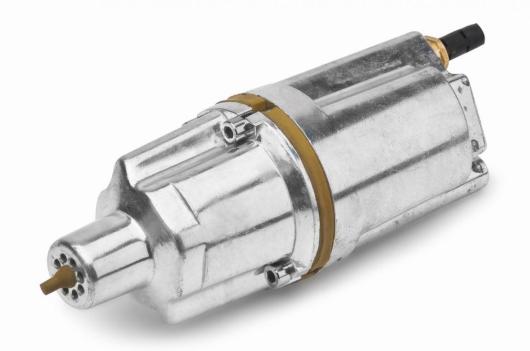
Vibrational ones are afraid of silt and sand particles, but at the same time they are not expensive, easy to install and unpretentious in work.
What parameters are important for choosing a pump
The same thing happens with a water pump; if you have a tank of water in the tank, you will avoid peak pump start-up energy; as well as extend battery life. Areas with shrubs, trees, aromatic, rose gardens, lawns, etc. A garden usually consists of different areas of plants, often with different irrigation needs, as in terms of the plant’s own requirements for garden use. If we add that the prudent use of water management benefits all of us, we must choose the most efficient irrigation system or system for each case.
Surface pumps
When deciding which irrigation pump is best for the site, pay attention to surface installations. They are used for irrigation with water pumped from shallow wells (up to 10 meters) and open reservoirs.
Such units are installed on the surface of the soil. Before starting work, they need to be filled with water through a special hole.
This means that various irrigation systems can be applied in the garden, which together with its programming allow you to save your energy and shine with the least possible water. There are various types of irrigation and easy application, among which we distinguish the following.
Automate irrigation by saving water
Hose irrigation Irrigation with surface sprinklers Drip irrigation Underground irrigation. All of these systems can be automated by including one or more programmers if there are several sectors or zones for irrigation. Very compact programmers have been designed and are easy to use. Connected to a humidity sensor, programmers move from hunting to empty water! Thanks to its regular measures, a moisture sensor allows you to accurately assess soil moisture and stop irrigation if it is not necessary.
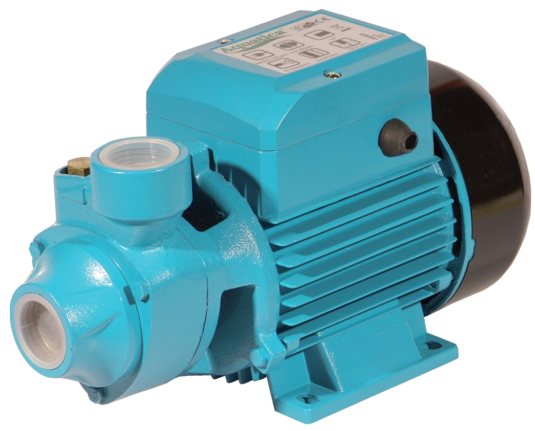
For water intake from surface pumps, a reinforced hose is used that is lowered into the source. A regular rubber watering sleeve is not suitable for such equipment. The reason is that the vacuum created in the suction line compresses the hose and stops the operation.
Different types of programmers
Thus, the earth is never saturated with water because it receives the exact amount that it needs. There are two types of programmers. For irrigation zone. . The advantage of automation is that it allows us to manually forget it, in order to be able to do it during those hours when evaporation is less, during specific times, which avoids drains and excesses of unwanted water, besides the fact that they can regulate the amount of irrigation daily changing them depending on the weather, etc. they also contribute to saving water and are more respectful of the environment.
The advantage of surface pumps is ease of installation and good performance. By installing such an aggregate near the well, you can irrigate the soil in a radius of up to 50 meters. The downside is the increased noise level.
Barrel pumps
If there are several storage tanks on the site (barrels, tanks), then for irrigation it is best to buy a barrel pump. It is inexpensive, compact and does not create a lot of noise during operation. The weight of such a device does not exceed 4 kg, so it can be freely carried around the site, alternately putting on barrels of heated water.
Groundwater use
Sometimes we have the opportunity to use water from a well or sounding. In this case, a large saving of water is the installation of a pressure pump for irrigation. There are two types of pressure pumps. The surfaces of these pumps are ideal for wells or deposits, they come out of the water, and they are connected to it thanks to the suction pipe. They are manual, and if we need to make them automatic, we will have to adapt the flow switch in the pipe between the pump and the installation.
- These pumps can be manual or automatic.
- These pumps fall into the water and lift it under pressure to the water.
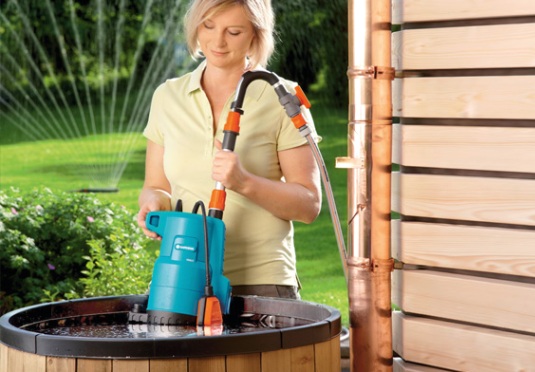
The barrel irrigation pump has a pressure regulator to smoothly change the pressure force and a filter to clean the water from debris. Choosing such a unit, you need to pay attention to its performance (liters per hour) and to the maximum volume of capacity with which it can work.
Thanks to the filter that connects to the gutter, the water is clean and without residue. To use water, there are easy-to-install pumps from which you can use water in the tank, giving pressure and facilitating simple irrigation, either through a hose with a gun or a sprinkler, as well as using drip systems.
Video: Useful Vibration Pump Operation Tips
Watering at sunset prevents the evaporation of 60% of the supplied water. When it is very hot, watering in the afternoon limits the loss of water by evaporation. When it is cold at night, it is better to drink in the morning so that there is no frost at night. By supplying water directly to the roots of plants, slugs, weed growth and useless water losses are avoided.
Drainage pumps
They are used to draw water from open reservoirs, although their main purpose is to pump out cesspools and flooded basements. The drainage water pump is not afraid of debris and large solid particles. It can easily cope with watering, even if the source of water is a pond overgrown with duckweed and mud.
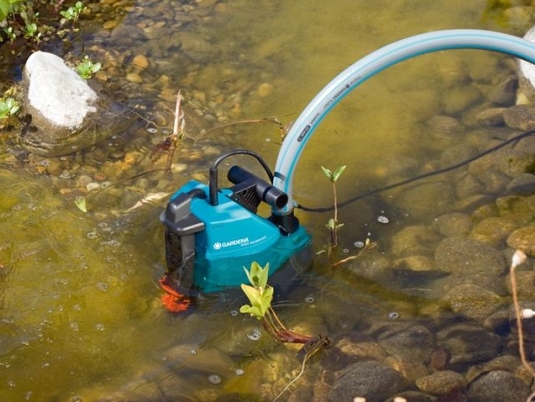
On some units are placed grinders, grinding organics. Therefore, having bought such an aggregate, you, along with irrigation, get the opportunity to fertilize the soil.
Drip irrigation pump
Saving water is a useful activity, especially when it comes to hundreds of cubic meters of moisture supplied to the site during the season. The best option for such work is an automatic centrifugal pump for drip irrigation. It is equipped with a hydraulic accumulator, pressure switch and pressure gauge.
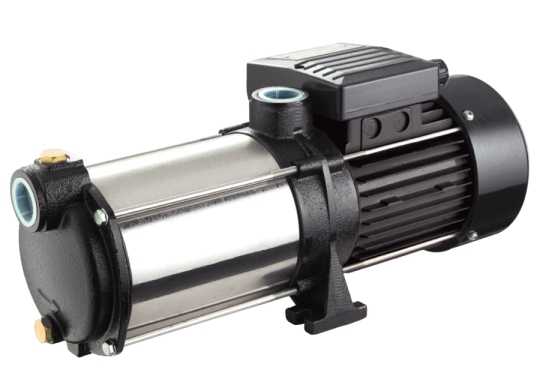
By setting the timer for watering duration and minimum pressure, the owner can safely go to work. A smart pump through a pipe system will economically deliver water to where it is needed.
How to calculate the performance of a watering pump?
Here, averaged irrigation rates will come in handy. According to them, watering 1 m2 of beds requires from 3 to 6 liters of water per day. This means that for a garden area of \u200b\u200b1 hundred parts, you will need a minimum of 300 and a maximum of 600 liters of liquid.
The pump should pump such volume in about 1 hour. Therefore, you need to buy a unit with a capacity of at least 300 l / h. This parameter, denoted by the letter Q, is always indicated in the data sheet and is duplicated on the body of the water pump.
The second characteristic is the developed pressure. It is denoted as the maximum height of the liquid. There is a simple correlation between the height of the lift and the horizontal water supply: 1 meter of height is 10 meters of pumping over the surface.
Therefore, if you see a lift height of 40 meters on the unit’s label, this means that the pump can supply water 400 meters horizontally (maximum). Or they can raise water 10 meters from the well, and then feed it 300 meters to your garden.
This is a theoretical calculation. In practice, it is necessary to take into account the pressure loss at the bends of the pipeline, leaks through the connections. On average, it is about 20%. Be sure to make this amendment in the final calculation of the pump unit.
The engine power of the pump depends on the type of irrigation selected. For the drip and root, a low-power unit is enough, but for sprinkling, a system that develops a lot of pressure will be needed.
Famous brands, estimated prices
The watering pump is not bought for one year, so it is better to purchase a reliable unit of a well-known brand than to regularly repair a cheap model.
Popular brands of pumping equipment are widely heard. These are the German Karher (Karcher) AL-Ko (Alco) and Gagdena (Gardena), as well as the Italian brand Pedrollo (Pedrollo). They do not cause trouble to the owners either at work or during the service period.
A barrel pump for watering these companies can be bought at a price of 5 500 rubles (lifting height 11-14 meters, productivity 60 l / min). Surface and submersible pumps of German manufacturers are sold at a price of 6,000 rubles. For drainage installations of small and medium capacity you have to pay from 4 to 9 thousand rubles
A lot of positive reviews apply to domestic watering pumps Dzhileks, Malysh and the Belarusian Stream. At a very affordable price, they are reliable and easy to use. Barrel pumps Kid and Trickle can be bought at a price of 1500 rubles. Not much more expensive are submersible vibration pumps of these companies (1500-2000 rub.).
Prices for domestic submersible pumps (centrifugal) start at around 5,000, and drainage plants can be bought for an average of 4-5 thousand rubles.
Garden, kitchen garden, flower beds, lawns - everything needs regular watering. Conventional pumps for water supply do not always cope with this task - watering has its own characteristics, because the pump for watering the garden, garden, flower garden and lawn is selected separately using a completely different approach.
Water source and irrigation pump categories
- well;
- well;
- river, pond, pool;
- containers and barrels.
In the case of a well and a well, the technical characteristics will be decisive - it is necessary that the water with the proper pressure be delivered to the irrigation site. Models are basically any. Choose to your taste.
If we are talking about a small river, a pond or a pool, then the requirements for the degree of water pollution are added to the technical characteristics. If the water in the pool can still be considered conditionally clean, then there will be enough pollution in the river or pond, so conventional equipment will not work. Conventional models in this case will not work, as they are designed for clean water. Contaminated water can pump drainage and garden pumps. Among these categories, it’s worth looking for a pump for watering the garden in this case.
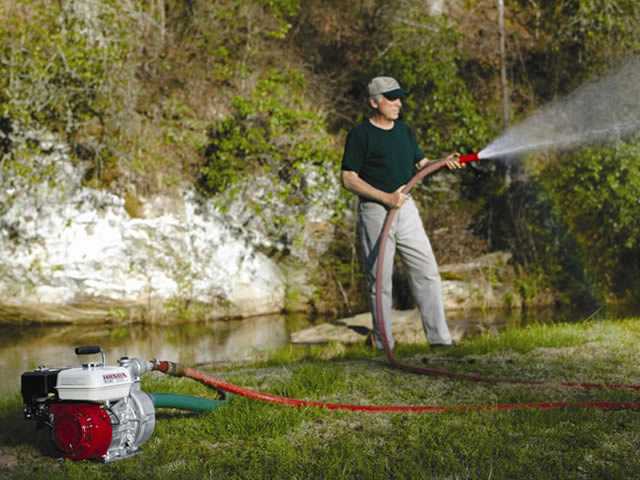
When watering from containers and barrels, the task becomes even more interesting. Water in this case is also not clean, so drainage pumps are suitable, but not any, but the most low-power ones. It's all about the amount of water that can be contained in a barrel. With a high capacity of 200 liters of water, an average power pump will pump out in 1-3 minutes. You will have time to water a little during this time, but there is already no water. Therefore, the best in this case are the most low-power (they are part-time and the cheapest). Only when buying, pay attention that the pump comes with a float water level sensor. If there is very little water left, this sensor will turn off the power.
Some companies produce special pumps for barrels. They are just characterized by low productivity and the ability to pump contaminated water, have small dimensions and weight, but at a price more expensive than similar drainers. But the barrel pump for watering the garden is compact and lightweight.

By the way, to solve the problem with quickly running out of water in the barrel is simple. There are usually several of them on the site. Just above the bottom level, you can weld the fittings with taps and connect all the barrels with pipes. So it will be possible to pump water from all barrels without shifting the hose.
Types of pumps, their advantages and disadvantages when using for irrigation
Choosing a pump for watering the garden is not an easy task - you need to decide on many parameters, take into account the features of pumps and water sources. You need to pick up such a “pair” so that it would be convenient for you to water, and the equipment worked in normal rather than emergency mode.
Submersible
Submersible pumps can be used to pump water from any source of sufficient volume - a well, well. It’s problematic to pump from a pond and a river even with a sufficient amount of water - the water is not clean, and ordinary models only feel normal with it. With a very great desire, you can make a camera filter in which to place the pump itself. But this is also a controversial option - the walls of the camera may break or clog.
In wells or boreholes, both vibrational and centrifugal submersible pumps can be used. The difference is that centrifugal can “deliver” water over long distances and lift it from great depths. Vibrational characteristics have more modest characteristics, shorter life, are more demanding on the purity of water, but the price is much lower. This explains their popularity.
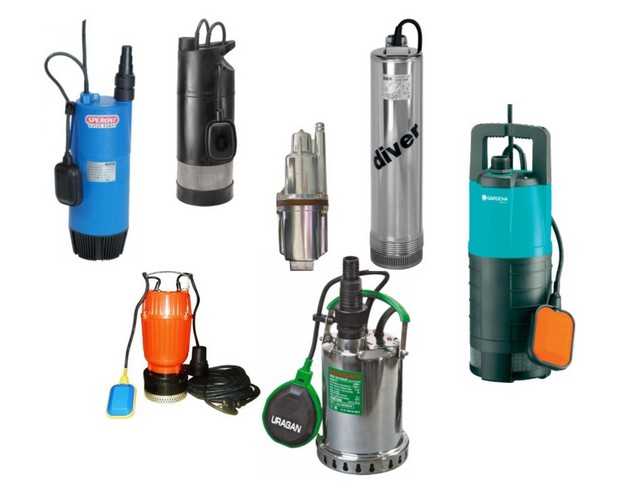
Submersible pumps are of various types (vortex and vibration), can work with different water - clean, dirty and very dirty
As for the river and the pond, they have already said that there are still tanks left. You can’t put a centrifugal unit into a barrel or a Eurocube - it will pump it out in a few seconds. Vibration will create a very strong rumble, although it will take several minutes to “pull” water. But the rumble is such that neighbors can come. So that is also not very suitable for such working conditions.
So, for a submersible pump for watering the garden, it is suitable if the water source is a well or a well without sand.
Drainage
Drainage pumps are mostly submersible. What sets them apart is their ability to work with muddy and polluted water. In this regard, drainage pumps are used just for watering the garden from open water sources - rivers, ponds, etc.
But just remember that dirty water is not duckweed and mud, but water, which contains solid particles no larger than 5 mm in size. But some manufacturers define other frameworks for their equipment - often the particle size should not exceed 3 mm. Therefore, if the body of water is heavily polluted, the same chamber with mesh walls is required, which will retain large contaminants. If you are reluctant to bother with this, and the water is really dirty, you can use not a drainage pump for irrigation, but. He can even pump silt. There are models with a grinder that crush large objects in seconds.
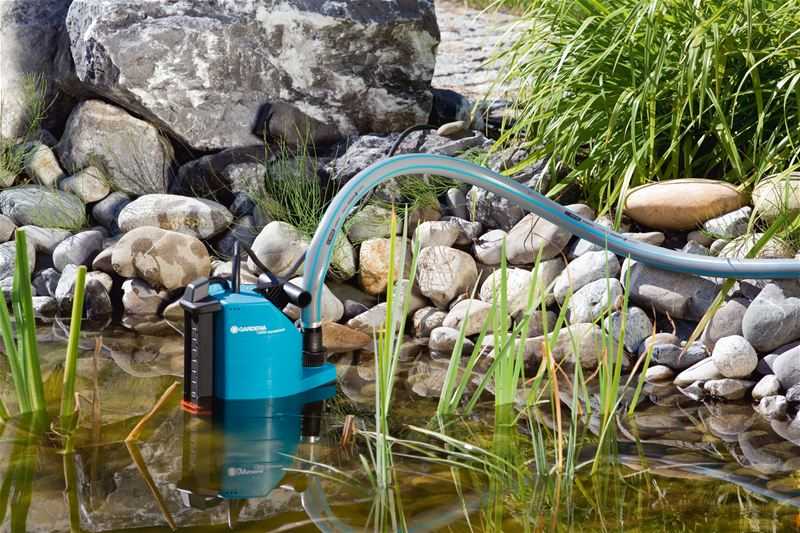
So, a drainage pump for watering the garden is good if the water has a significant amount of impurities, but all of them are no more than 3-5 mm. With large contaminants, it is more advisable to use a fecal aggregate.
Barrel
Another type of submersible pump, designed specifically for irrigation from small tanks - barrel (barrel) pumps. They have low performance, low power and size, low noise. When the water level in the tank decreases, they gradually increase the pressure so that the pressure at the outlet remains stable. In general, such a pump for watering the garden is a good purchase, but ... if you are satisfied with the price.
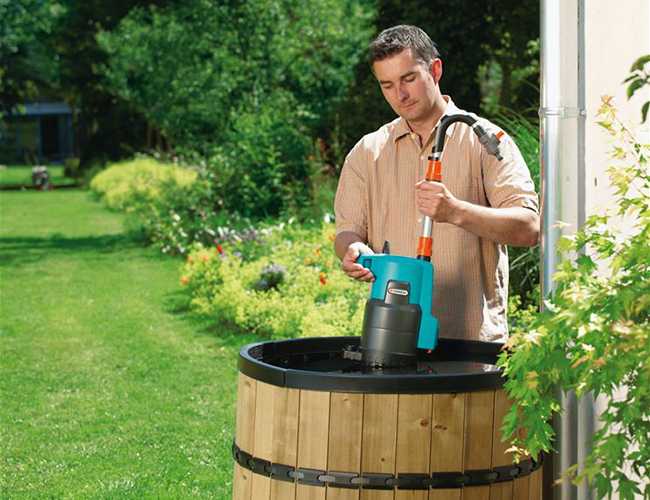
The inlet of the barrel pump is closed by a mesh - filter from large contaminants. But this is far from always enough. If the barrel is a lot of dirt, make an additional filter. You can even drop a piece of gauze or other mesh fabric (old tulle, for example) into the barrel, fix it so that it does not reach the bottom a little. The unit can be lowered into this fabric. In this case, it will work longer without maintenance (it is necessary to periodically clean from dirt that accumulates inside). The fabric will not pull in during operation - there is a mesh there, so the option is quite capable.
Outdoor
Outdoor pumps are more suitable for watering a garden from a river or pond. Only the hose is lowered into the source, and the unit itself remains on the surface. Just keep in mind that the hose must be reinforced - the usual one simply flattened by the negative pressure created during operation.
The disadvantages of this type of equipment include their weight - they are usually quite heavy, which makes it difficult to carry. Their case is made of steel or cast iron, and it is clearly not light. To eliminate this drawback, special garden pumps were invented. Their case is made of plastic, which makes them much easier - even a woman can easily handle carrying. In addition, garden pumps are better suited for pumping not quite clean water. So for watering the garden from the river, this is a good choice.
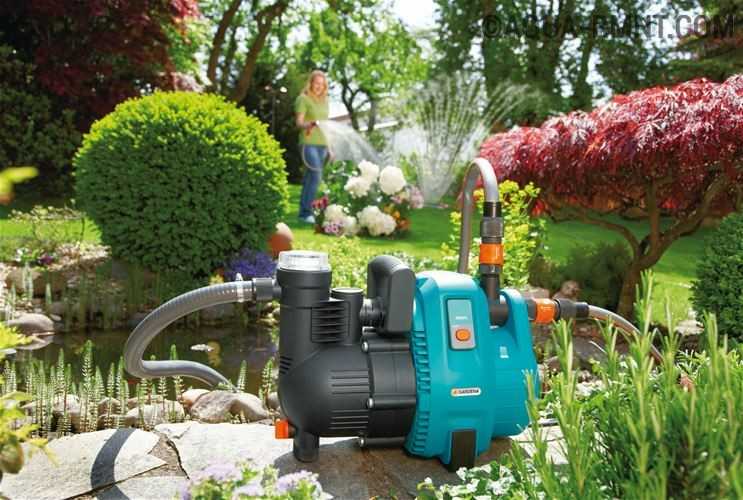
Outdoor pumps are good for everyone, but filling them before starting work is not the most interesting activity.
There is one nuance in working with external suction pumps: in order to start them, you first need to fill the pump and the hose with water. An external pump for watering the garden according to the method of operation can be, then you need to “refuel” a little - only the capacity in the pump, and this is several hundred milliliters. If the model is normally suction, it is necessary to fill the entire hose and the capacity of the unit, and this may be more than one dozen liters. Since watering is a periodic action, refueling such a system is tedious every time. Therefore, for watering the garden using self-priming outdoor pumps or looking for something else.
There are external vortex pumps (centrifugal), but they are only suitable for clean water. That is, this is another option for a well or well, but with a small depth. Their plus is that they do not need to be poured, although it is problematic to carry heavy ones from place to place.
Pumping stations for watering the garden
If you wish, you can use a pump station instead of a pump to water the garden. This, in principle, is an ideal option - the pressure is stable, and it can be regulated over a fairly wide range, while the motor is operating normally - it turns on and off. But without flaws in any way. Typically, pumping stations are equipped with surface pumps for clean water. They will have to be poured before starting, these are two. They are heavy - these are three. And the price is far from always pleasing - these are four.
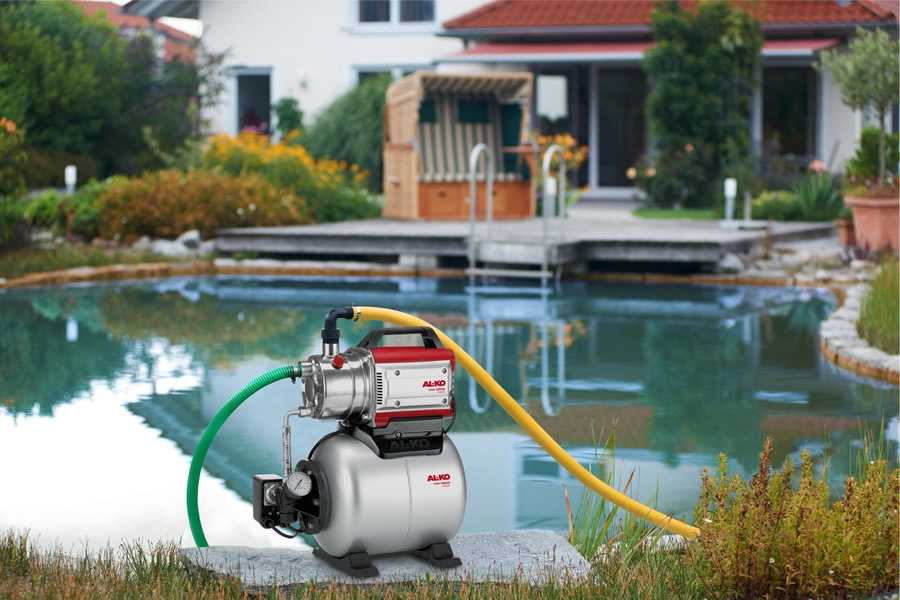
Pumping station for watering the garden - convenient, but not cheap
True, if you wish, you can assemble the station yourself, and on the basis of any pump (drainage for example). You will need a manometer and a five-pin fitting or a set of flexible eyeliners with nuts of suitable diameters. You can also assemble the entire system on polypropylene or plastic, as you are used to. It’s not so difficult, so it’s real to understand.
Requirements
When choosing a pump for irrigation, it is necessary to take into account the specifics of the operation of these devices. It still differs significantly from the usual working conditions that are used for water supply at home.
Performance
You can water the garden with any type of aggregate, but there is one caveat: the power must be selected so that when using nozzles (irrigation gun, sprinkler, etc.) the hose does not break. And not the most pleasant moment is that with simple basal irrigation, less productivity is required - a strong stream will simply wash the soil. When using sprinklers or irrigation guns, the pressure should be greater - to capture a large area.
The only acceptable way out is to put a tee at the output of a decent power pump. Connect a watering hose to one outlet, and a hose to the second through the valve, which will divert part of the water back to the source. With this connection, by adjusting the amount of water returned by the valve, it will turn out to change the pressure of irrigation, and in a wide range.
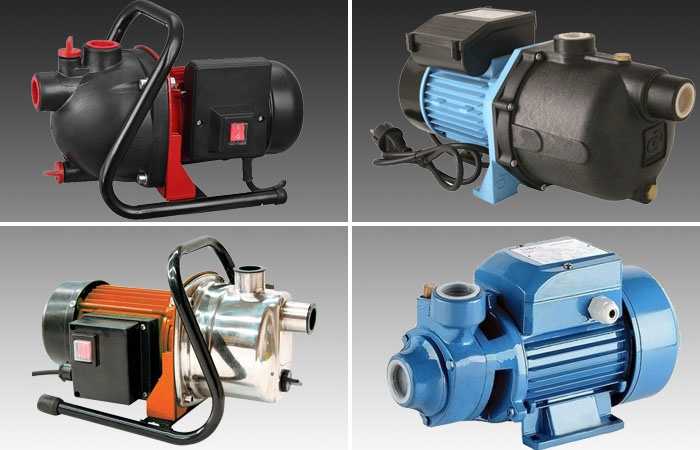
Surface pumps for watering the garden in plastic cases are garden models that were developed just for these purposes
Such a system is very useful when watering from barrels. When using even ordinary drains, barrels are pumped out very quickly. Such a focus with the return of water allows you to stretch the feed and water a large area.
If you are looking for a pump for watering a garden with low productivity, you will find that it is difficult to find units of good brands with low power. If they are, then at a high price. But there are a lot of cheap Chinese low-capacity pumps, which are also designed for pumping dirty water. This is exactly the option that is needed for irrigation from a barrel, pond or river. True, the percentage of marriage is high - 20-30%.
There are two solutions in this case - to buy a cheap pump, and if necessary, to buy a new one. The second way is to reduce the performance of a normal unit. This can be done by installing a smaller hose at the outlet. But this is bad for the pump - it will work, but the wear rate will increase significantly. To improve working conditions, you can lead to the point of irrigation with a regular-size hose, and only then install the adapter. It’s not that it will drastically improve the situation, but the water flow will be less and the pressure will be strong - you can use sprinklers and other nozzles.
Protection against overheating and dry running
Since the pump works for watering the garden for a long time, and often not in the best mode for it, it is quite possible that the motor overheats. Therefore, it is very desirable to have protection against overheating (thermal relay). A very useful option - when the threshold temperature is reached, the power supply simply turns off.
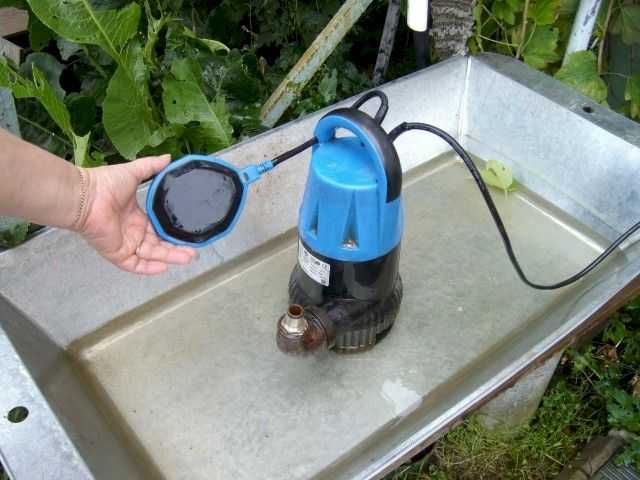
Any source of water may be scarce. Even from a well or a well, it can be pumped out. If the pump works for some time without water, it will burn out - water serves at the same time to cool the housing. Because they put it. The most popular, easiest, most reliable and cheapest way is a float. This is a water level sensor, which, if not enough, simply cuts off the power supply. There are pumps for watering the garden, which immediately come with such a device, and if not, it can be installed independently - by connecting the wires from the sensor to the gap of one of the supply wires.
Parameter Definition
As for productivity, we have already decided - it needs a small one - about 3-5 cubic meters per hour (this is 3000-5000 liters per hour), which is more than enough to irrigate the garden and vegetable garden.
What will need to be considered is the pressure of the pump. This is the amount by which water can be pumped. The pressure usually consists of two components - vertical and horizontal. Vertical - this is the depth from which you have to raise water. There it is, it is - every meter of depth is equal to one meter of pressure. Only in the technical specifications for the pumps is there such a line as “maximum suction depth”. So, it should be at least 20-25% greater than the available depth. You can take it back to back, but only with branded equipment, since Chinese indicators are usually significantly overstated.
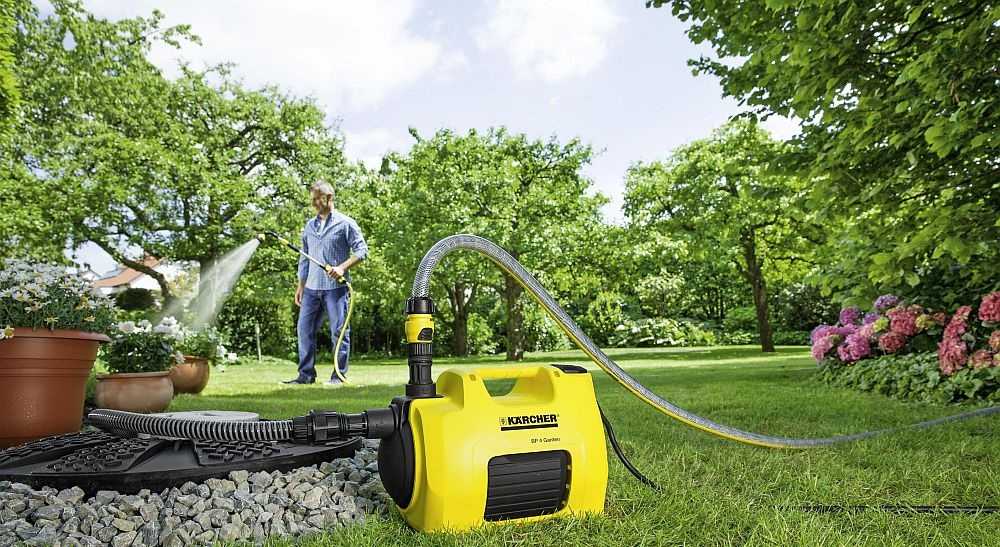
The horizontal component of the pump head is the distance that the raised water will have to be transported to the irrigation site (when calculating, take the farthest point). When using an inch pipe or hose, it is estimated that 1 meter of lift is required per 10 meters of horizontal pipe. As the diameter decreases, the number becomes smaller - for example, 3/4 of an inch counts 7 meters of pipe / hose per 1 meter of lift.
Also, the resistance of the pipes (hoses) will have to be taken into account. To do this, add about 20% to the calculated value.
An example of the calculation of pressure. The water mirror is located at a distance of 6 meters from the surface, we will swing from a depth of 8 m, it will be necessary to transmit from the sampling point to 50 m. The pipe is inch, therefore we consider the horizontal head at 10 m.
So: the total head is 8 m + 50m / 10 \u003d 13 m. Add a margin for losses at the joints (20% of 13 m is 2.6 m), we get 15.6 m, after rounding - 16 m. When choosing a pump for irrigation see that its maximum pressure is not less than this figure.
